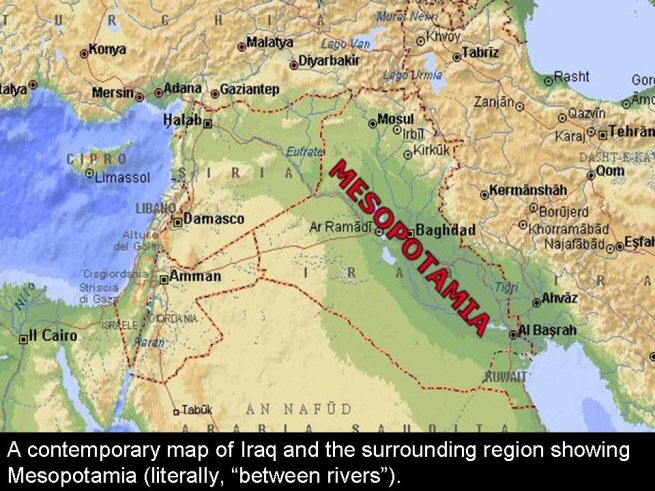| View previous topic :: View next topic |
| Author |
Message |
iraqia_Jasmin

Joined: 06 May 2006
|
 Posted: Fri Aug 06, 2010 8:49 pm Post subject: History of Arabic Culture Posted: Fri Aug 06, 2010 8:49 pm Post subject: History of Arabic Culture |
 |
|
|
|

 History of Iraq
History of Iraq
Historically, Iraq was known in Europe by the Greek exonym 'Mesopotamia' (Land between the rivers); after the foundation of the Kingdom of Iraq in 1932, it became known by its ancient endonym 'Iraq'. Iraq has been home to continuous successive civilizations since the 6th millennium BC. The region between the Tigris and Euphrates rivers is identified as the cradle of civilization and the birthplace of writing and the wheel.
Iraq has been home to continuous successive civilizations since the 6th millennium BC. These civilizations produced the earliest writing, literature, sciences, mathematics, laws, and philosophies of the world; hence its common epithet, the "Cradle of Civilization".
Iraq was home to the earliest known civilization on Earth, the Sumerian civilization, which arose in the fertile Tigris-Euphrates river valley of southern Iraq in the mid 6th millennium BC. It was here in the late 4th millennium BC, that the world's first writing system and recorded history itself were born. The Sumerian civilization flourished for over 3000 years and was succeeded by the rise of the Akkadian Empire in the 24th century BC. Over two centuries of Akkadian dominance was followed by a Sumerian Renaissance in the 21st century BC. An Elamite invasion in 2004 BC brought the Third Dynasty of Ur to an end. By the 18th century BC a new civilization, Babylonia, had risen to dominance in central and southern Iraq while a contemporaneous civilization, Assyria, had formed in northern Iraq.
Around 75-80% of Iraq's population is Arab; the other major ethnic groups are the Kurds at 15.2%,[67] the Assyrians, the Iraqi Turkmen and others (5%),[67] who mostly live in the north and northeast of the country. Around 20,000 indigenous Maʻdān people live in southern Iraq.[68] The Iraqi population includes a community of around 20,000 Armenians, a small community of Circassians,[69] and a community of 2500 Chechens.[70] In southern Iraq there is a community of Iraqis of African descent, a legacy of the slavery practiced in the Islamic Caliphate beginning before the Zanj Rebellion of the 9th century AD, and Basra's role as a key port city.
Sumer and Akkad
Sumer was a civilization and historical region in southern Iraq. It is the earliest known civilization in the world and is known as the Cradle of Civilization. The Sumerian civilization spanned over 3000 years[5] and began with the first settlement of Eridu in the Ubaid period (mid 6th millennium BC) through the Uruk period (4th millennium BC) and the Dynastic periods (3rd millennium BC) until the rise of Babylonia in the early 2nd millennium BC.
The Ubaid period marks the Pottery Neolithic to Chalcolithic phase in Mesopotamia, which represents the earliest settlement on the alluvial plain in the south. Early urbanization begins with the Ubaid period, around 5300 BC. The Ubaid culture gives way to the Uruk period from c. 4000 BC. The invention of the wheel and the beginning of the Chalcolithic period fall into the Ubaid period. The Sumerian historical record remains obscure until the Early Dynastic period, when a now deciphered syllabary writing system was developed, which has allowed archaeologists to read contemporary records and inscriptions. Classical Sumer ends with the rise of the empire of Akkad in the 23rd century BC. Following the Gutian period, there is a brief "Sumerian renaissance" in the 21st century, cut short in the 20th century BC by Amorite invasions. The Amorite "dynasty of Isin" persisted until ca. 1700 BC, when Mesopotamia was united under Babylonian rule.
Ubaid period: 5300 – 4100 BC (Pottery Neolithic to Chalcolithic)
Uruk period: 4100 – 2900 BC (Late Chalcolithic to Early Bronze Age I)
Uruk XIV-V: 4100 – 3300 BC
Uruk IV period: 3300 – 3000 BC
Jemdet Nasr period (Uruk III): 3000 – 2900 BC
Early Dynastic period (Early Bronze Age II-IV)
Early Dynastic I period: 2900 – 2800 BC
Early Dynastic II period: 2800 – 2600 BC (Gilgamesh)
Early Dynastic IIIa period: 2600 – 2500 BC
Early Dynastic IIIb period: ca. 2500 – 2334 BC
Akkadian Empire period: ca. 2334 – 2218 BC (Sargon)
Gutian period: ca. 2218 – 2047 BC (Early Bronze Age IV)
Ur III period: ca. 2047 – 1940 BC
Babylonia and Assyria
Babylonia was a state in central and southern Iraq with Babylon as its capital. During the third millennium BCE, there developed a very intimate cultural symbiosis between the Sumerians and the Akkadians, which included widespread bilingualism. The influence of Sumerian on Akkadian (and vice versa) is evident in all areas, from lexical borrowing on a massive scale, to syntactic, morphological, and phonological convergence. This has prompted scholars to refer to Sumerian and Akkadian in the third millennium as a sprachbund.
Akkadian gradually replaced Sumerian as the spoken language of Mesopotamia somewhere around the turn of the 3rd and the 2nd millennium BCE (the exact dating being a matter of debate), but Sumerian continued to be used as a sacred, ceremonial, literary and scientific language in Mesopotamia until the first century CE.
Babylonia emerged out of the Amorite dynasties (c. 1900 BC) when Hammurabi (c. 1792 BC – 1750 BC), unified the territories of the former kingdoms of Sumer and Akkad. The Babylonian culture was a synthesis of Akkadian and Sumerian culture. Babylonians spoke the Akkadian language, and retained the Sumerian language for religious use, which by Hammurabi's time was declining as a spoken language. The rulers of Babylonia carried the title "King of Sumer and Akkad".
The earliest mention of the city of Babylon can be found in a tablet from the reign of Sargon of Akkad, dating back to the 20th century BC. Following the collapse of the last Sumerian "Ur-III" dynasty at the hands of the Elamites (2002 BC traditional, 1940 BC short), the Amorites gained control over most of Mesopotamia, where they formed a series of small kingdoms. During the first centuries of what is called the "Amorite period", the most powerful city states were Isin and Larsa, although Shamshi-Adad I came close to uniting the more northern regions around Assur and Mari. One of these Amorite dynasties was established in the city-state of Babylon, which would ultimately take over the others and form the first Babylonian empire, during what is also called the Old Babylonian Period.
[b]Persian Babylonia
Babylonia was absorbed into the Achaemenid Empire in 539 BC.
A year before Cyrus' death, in 529 BC, he elevated his son Cambyses II in the government, making him king of Babylon, while he reserved for himself the fuller title of "king of the (other) provinces" of the empire. It was only when Darius Hystaspis acquired the Persian throne and ruled it as a representative of the Zoroastrian religion, that the old tradition was broken and the claim of Babylon to confer legitimacy on the rulers of western Asia ceased to be acknowledged.
Immediately after Darius seized Persia, Babylonia briefly recovered its independence under Nidinta-Bel, who took the name of Nebuchadnezzar III, and reigned from October 522 BC to August 520 BC, when Darius took the city by storm. A few years later, probably 514 BC, Babylon again revolted under Arakha; on this occasion, after its capture by the Persians, the walls were partly destroyed. E-Saggila, the great temple of Bel, however, still continued to be kept in repair and to be a center of Babylonian religious feelings.
It has long been maintained that the foundation of Seleucia diverted the population to the new capital of Babylonia, and that the ruins of the old city became a quarry for the builders of the new seat of government, but the recent publication of the Babylonian Chronicles of the Hellenistic Period has shown that urban life was still very much the same well into the Parthian age.
The name of the satrapy was changed to Asuristan in the Sassanid period. Excepting brief interludes of Roman conquest (Roman Assyria, Roman Mesopotamia; AD 116 to 118), and a longer period of Hellenistic rule (the Seleucid Empire, 330 to 250 BC), Mesopotamia remained under Persian control until the Islamic conquest in the 630s |
|
| Back to top |
|
 |
|
|
|
|
You cannot post new topics in this forum
You cannot reply to topics in this forum
You cannot edit your posts in this forum
You cannot delete your posts in this forum
You cannot vote in polls in this forum
You cannot attach files in this forum
You cannot download files in this forum
|
Couchtripper - 2005-2015
|




